BLESSINGS OF GANESHA FROM ARUNACHALA
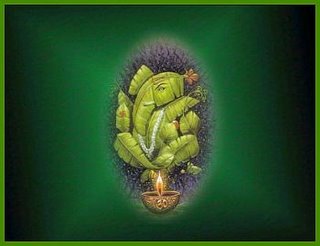
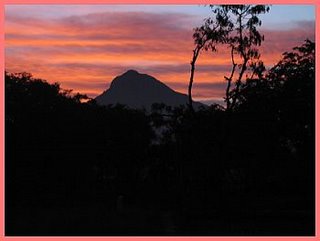
Hesitant light glows, shaded in hues of crimson
Purple strands wrap around rosy fabric
Shining whispers gaining strength with each passing moment
Growing courage and covering the haloed heavens
With a splendid legacy of auspicious hope
Billowed vapors coalesce, gathering to bloom
Fields of mystic blossoms bending low to breezes
Sensitive, each responsive flower turning its face
Into the brilliance of the morning sun
To float away and meet the distant horizon
Feathered friends of angels soar on cushioned air
Singing songs of glorious restoration
Hopeful joy lands delicate, tenderly embracing
Uniting memoirs of yesterday with the promise of today.
[unknown]


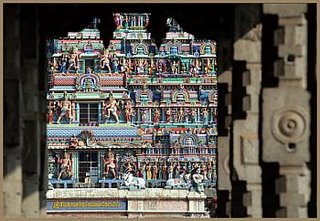
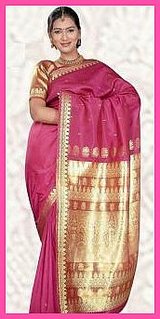

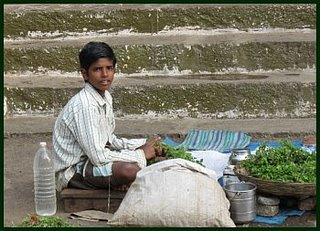
Below is one of the rest-a-while parks that are dotted around the fringe of the pradakshina pathway. Unfortunately the parks nearly always seem to be locked, maybe the park caretakers don't trust us enough to keep the park clean in their absence! A Bonnet Macaque monkey is hanging around in front of the park. At the beginning of my walk I bought a large bag of rusk bread for the monkeys and dogs but ran out of supplies quickly and had to purchase more on the way.
Please do remember if you feed the monkeys to throw the food off the road. Even though it is easier for them to pick up food from the tarred roads, doing so makes the monkeys lose their fear of the street and so leads to accidents. The monkeys are tame and generally very well mannered.

These two kids are visiting Tiruvannamalai for the first time with their Mother. They hail from Chennai and were particularly proud of their nice, new tonsures from the Arunachaleswarar Temple.
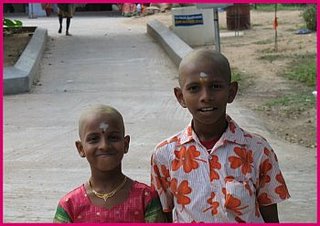
Unfortunately nobody keeps to the recommendations either regarding the use of the horn or speed restriction. Hopefully when the ring road finally gets built heavy traffic will no longer use the giripradakshina pathway.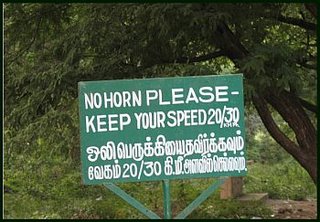
What you see below is becoming increasingly common on the giripradakshina road. About 10 years ago the pathway was unlighted and in a narrow and poor, rutted condition. Even though the intentions were kind hearted, the consequences of widening the road and providing bright lighting, has had unfortunate consequences. Because now pilgrims do not have right-of-way and are consistently pushed to the side of the road by speeding trucks and buses. This situation unfortunately doesn't improve during the evenings and nights because sadly, as the lighting is so excellent, heavy traffic constantly travels on the road.

This decorated tree is a new item. In India ladies like to ornament special trees (specially located at shrines or holy spots) with personal items like bangles or auspicious threads in performance of a vow. I think this particular tree has been helped along by some enterprising folk who thereafter take up a nearby perch and sell items such as camphor and small clay plates, so that pilgrims can perform aarti (the waiving of light) to the tree.

Parents love to dress their children up like dollies. This little girl looks adorable with her bangles, flowers and necklace. The Mother, who was standing next to the child as I took the picture, was delighted that her beautiful angel was being admired and photographed.
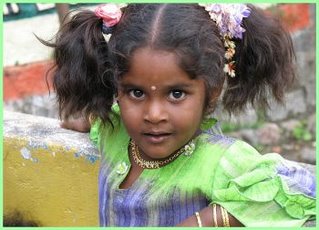
These gents are devotees of the God, Iyyapan. They are on their way to the famous Iyyapan Temple at Sabrimala. The journey to the Iyyapan Temple is almost as important as what happens once the pilgrim arrives. It is traditional that the journey itself is a pilgrimage, and devotees on their way to Sabrimala will stop off at designated shrines, holy places, saints or sadhus to perform different worships. A unique aspect of Sabrimala, is that there is a sex restriction. Gents are allowed, but as to ladies, only girls or older ladies are allowed to visit and ladies of childbearing age are not welcomed.



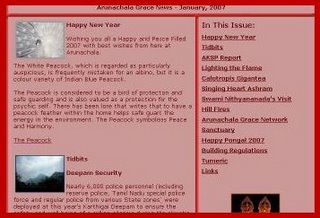
Arunachala Grace News, January 2007, is being sent out this week. The newsletter is completely free and is sent directly to your inbox. This month there is a report from Apeetha Arunagiri of the Arunachala Kattu Siva Plantation, a narrative from Govinda Bowley of the Mountain of Medicine about the Hill Fire on Arunachala during this year's Maha Deepam on December 3rd. We have news of the innovative work being done at the 'Singing Heart Ashram', a 'Tidbit Section' including a round-up of the latest news at Tiruvannamalai, information about the upcoming January visit of Swami Nithyanananda and also, reports on the herbs of Arunachala, poems and a wonderful satirical report on local 'building regulations'.
 [photograph of Sri Sadhu Om in front of Arunachala]
[photograph of Sri Sadhu Om in front of Arunachala]Soon after reading his book, I met Sri Sadhu Om, and I found that he was able to answer in an extremely clear, simple and convincing manner all the questions that I asked him about the philosophy and practice of the teachings of Sri Ramana. For the next eight-and-a-half years, until his passing away in March 1985, I was fortunate to be able to spend most of my waking life in the company of Sri Sadhu Om, and to imbibe from him a clear understanding of the philosophy, science and art of true self-knowledge as taught by Sri Ramana."
Michael James ended up living at Arunachala for the next twenty years. He has now launched a website and hopes to continue adding more content to his site in the form of e-books, articles, translations and explanations of all the original writings of Sri Bhagavan.
At present the main content of the site is a PDF version of his new book, 'Happiness and the Art of Being', which is intended to serve both as a layman's introduction to the philosophy and practice of Bhagavan's teachings and as a detailed and in-depth exploration of the core elements of those teachings. To find out more about the life of Michael James, his teacher Sadhu Om and the teachings of Self-Enquiry please visit: www.happinessofbeing.com

An NGO (Non Governmental Organisation) which has been working for the uplift of blind people, has come up with a scheme entitled 'Nethradhenu' that would lend a helping hand to the visually impaired. The project, introduced six months ago, has members from Tamil Nadu Districts including Tiruvannamalai and is based on a Government scheme created to help elderly people in villages. In the case of 'Nethradhenu', the beneficiaries are visually-impaired illiterates in their 40's who are dependent on others. Under the scheme a Jersey cow and calf is given free of cost to a visually impaired recipient. The cow will be insured and it's milk will be procured by a private milk company.
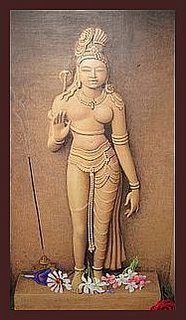
The effects of Arunachala can either begin while one is here or may manifest weeks after one has departed. It bodes very well as now a different type of energy is coming to town and people will be thereby influenced in many new extraordinary ways.
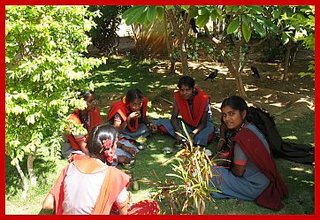


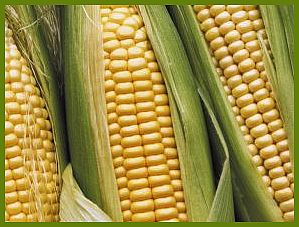


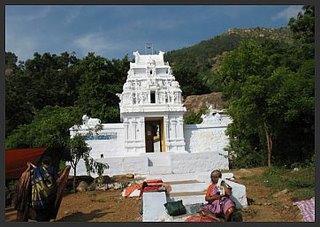
Guhai Namasivaya is known to have been born around the year AD 1548 in Karnataka to a pious Saiva couple. His spiritual nature became evident at an early age: he was virtuous in his conduct, adept at his studies and evinced no attachment to worldly matters.
He practised his system of yoga for many years and as a result of the dream guidance of Lord Mallikarjuna, the presiding deity of Sri Sailam, Guhai Namasivaya came to Arunachala and remained as a Guru, giving teachings to mature disciples who approached him.
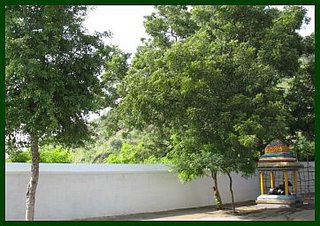
There is a famous story concerning Guhai Namasivaya that seems to show that although he had great devotion to Arunachala, he was still capable of displaying bursts of extreme anger. One day, according to this story, he took pity on a poor man whose only goat had been killed by a snake just before it was about to give birth. Guhai Namasivaya asked the man to leave the goat's body with him and to collect it the next day. When the man returned to pick up the corpse, he found that not only had the goat been restored to life, it had also given birth to two kids.
As news of this miracle spread around the town, some boys from the local weaving community decided to play a joke on him. One boy, pretending to be dead, was carried into the presence of Guhai Namasivaya by his friends. The boys claimed that their friend had died of a snake bite and asked the saint to restore him to life. Guhai Namasivaya, who could see that they were merely making fun of him, cursed them with such vehemence that the boy who was pretending to be dead actually did die.
Then Guhai Namasivaya cursed the whole weaving community, saying that they would never prosper or flourish in Tiruvannamalai again. The curse took effect: all the weavers were forced to leave town or take up other occupations because none of them could make a living by weaving in Tiruvannamalai. In the years that followed, all attempts to re-establish weaving businesses in the town failed.
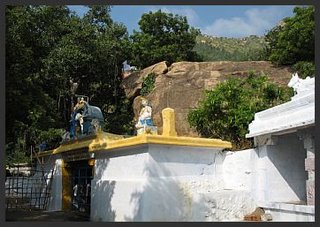
For a fuller biography of this famous saint please check link:
http://www.arunachalasamudra.org/guhainamasivaya.html

At the beginning of the pathway are huddles of houses, which are in actual fact encroachments that will probably be allowed to remain. As I got further up, the houses thinned out but occasionally spotted a small forest dwelling just off the pathway. This one rather reminded me of the tree dwellers in one of the Star Wars movie!

On the southeast slope across from the Temple is a profusion of caves, small shrines, temples, hutments and tirthams (water tanks).

The shrines are beautifully maintained as they receive many visitors and pilgrims who, in the Indian way, give generously whilst on pilgrimage.

The below photograph is of the inside of the Mango Cave. A famous cave that has been occupied by many saints and sadhus. It was also one of the caves that Sri Ramana Maharshi lived in whilst on the hillside. During his time at Virupaksha Cave, Ramana would (during the hot summer months) generally move to the cooler Mango Cave which also had an ample water supply.

One of the tirthams near the caves.

There is always lots of activity at the tirthams. In the below photograph you can see sadhus in the background and in the foreground, pilgrims with shaved heads. The pilgrims probably had their tonsures done at Arunachaleswarar Temple in performance of a vow. After the head is shaved the pilgrim will often cover the head with sandalpaste which is both cooling and also a protection against the sun. It is regarded as very auspicious to take a bath in a water tank around Arunachala. And in this respect some of the specific tanks and the merits accrued from bathing in them are mentioned in the Skanda Purana.

Here is a sadhu colony on the slope.

Statue carvers are quite common around Arunachala. Previously they were content in selling their wares off the Chengam Road and near the Temples. But now, due to the huge increase of visiting pilgrims on the pathways surrounding the caves and tirthams on the slope of Arunachala, they have sensibly decided to station themselves where the business end is!

Alot of them are very talented and you can purchase beautifully carved religious icons for a lesser price than in the shops. But remember you are expected to bargain!



Each sacred grove has a residing deity and folklore associated with it. They are usually dedicated to one of the following:
Village gods and/or ancient spirits;
Snake gods and/or an incarnation of Vishnu,
Shaivite gods (located in dense forests);
Vaishnavite gods (located in dense forests).
The village sacred groves are generally dedicated to Amman, the goddess of fertility and good health.
From time immemorial, certain trees and plants in India have been invested with divine attributes. Hindus have been taught to worship and revere trees and plants in the belief that it would influence their own personal well-being. Evergreen trees were regarded as symbols of eternal life and to cut them down was to invite the wrath of the gods. Groves in forests were looked upon as habitations of the Gods.
The banyan tree occupies the pride of place amongst the sacred trees of India. It has aerial roots that grow down into the soil forming additional trunks. It is, therefore, called bahupada, the one with several feet. It symbolizes a long life and also represents the divine creator, Brahma. It is invariably planted in front of temples. The numerous stems of the banyan tree are even regarded as the home of gods and spirits. It was under a banyan tree that the Hindu sages sat in a trance seeking enlightenment and it was here that they held discourses and conducted holy rituals.
The trees generally associated with sacred groves are the Banyan, Peepul and Neem trees.
In Tamil Nadu there has always been a strong tradition of nature worship and animism. Adjacent to the land of Rangammal School for the Hearing Impaired, there is a small, perfect grove with a beautiful banyan tree and a stone icon representation of Kali Ma. This sacred site has been revered by local villagers for an indeterminate time.

I was fortunately able to be present during a puja at the Sacred Grove and was able to hear about a fascinating experience one of the local teachers had at the shrine.
She told me that years back, after hearing about the Sacred Grove, she decided to visit it and pray to the representation there of the Divine Mother in the form of Kali Ma. When she arrived at the Grove there was a live cock hanging upside down from the metal frame on the left hand side of the stone icon. (The frame actually says OM in the Tamil language).
The frightened confused cock severely hurt himself on the protruding metal prongs and it got messy and nasty at the shrine. Frightened and distressed the teacher ran back to the school leaving everything as she found it. She was to learn that a black magician had tied the cock upside down at the Kali Ma icon as part of a magic ritual that he was performing for a client. For the teacher things were getting worse and worse. First the cock and now a black magician! So, believing that the place was cursed, she vowed never to go back to Kali Ma at the Sacred Grove.
Unexpectedly a mysterious, unknown stranger went to the teacher and told her not to be frightened and that he had 'spiritually cleansed the Sacred Grove and Kali Ma wanted her to come each month and perform puja there.'
Since that time now many years ago, the teacher regularly goes to the Sacred Grove. Also once a month, as commanded by the Divine, she performs worship at the Kali Ma shrine. She told me that she has found answers to all her prayers at the Sacred Grove and she knew it to be an extraordinary and powerful site where wishes come true.

The greatest danger to all reforestation programmes being undertaken at Arunachala is the possibility of fire. The fires are mostly man-made. In previous years wood cutters would raze dry existing grass on the Hill to promote new growth. Sometimes the fire was caused by people out of the superstitious believe that setting the Hill alight would somehow benefit their health or prospects.
What previously was shrugged off by the Municipality as high jinks is now being taken very seriously. In this respect a 52-year-old man of Thenimalai, a suburb of Tiruvannamalai, was arrested by forest department officials for allegedly causing a fire in the Tiruvannamalai hills on Saturday, December 9th.
According to sources, unidentified miscreants set grasses and woods in the hills on fire, causing damage to the area and particularly to trees developed by the afforestation programme carried out by the Forest Department and various Non Governmental Organisations (NGOs).
Fire-fighting squads and a team of volunteers helped extinguish the fire. The miscreant Palani, who was detained for allegedly causing the fire, is said to have confessed to his offence, saying that he committed the arson, driven by the superstition that setting the hills on fire would cure stomach ache!

P Lokanathan has been appointed as special officer for the upcoming new region of State Transport Corporation (STC).
During the last assembly session the Government announced the formation of a new State Transport Corporation region based at Tiruvannamalai.
Though Tiruvannamalai District was formed nearly two decades ago, there is no separate State Transport Corporation division for this District. As buses from the Vellore, Villupuram and Kancheepuram divisions are operating their buses in certain parts of this District, the Government decided to form a separate region based at Tiruvannamalai to bring the entire District under one administration.

One could say COMPLETE SUCCESS.